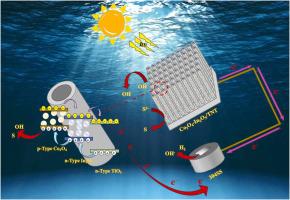当前位置:
X-MOL 学术
›
J. Alloys Compd.
›
论文详情
Our official English website, www.x-mol.net, welcomes your feedback! (Note: you will need to create a separate account there.)
Chemical bath co-deposition of Co3O4 and In2O3 on TiO2 nanotubes, aiming for photoanodes with improved photoelectrochemical properties
Journal of Alloys and Compounds ( IF 5.8 ) Pub Date : 2024-06-26 , DOI: 10.1016/j.jallcom.2024.175359 Mina Ebrahimi , Abbas Bahrami , Masoud Atapour , Mohamad Mohsen Momeni
Journal of Alloys and Compounds ( IF 5.8 ) Pub Date : 2024-06-26 , DOI: 10.1016/j.jallcom.2024.175359 Mina Ebrahimi , Abbas Bahrami , Masoud Atapour , Mohamad Mohsen Momeni

|
This study investigates the implications of the deposition of CoO and InO onto TiO nanotube thin films for the photoelectrochemical activity of TiO nanotubes (TNTs). Initially, TiO nanotubes were fabricated through an electrochemical anodizing process. Subsequently, a facile chemical bath deposition (CBD) method was used to deposition CoO and InO oxides. The resulting composites are used as photoanodes for the photoelectrochemical cathodic protection of AISI304 stainless steel (304SS) in marine environments. The surface morphology, compositions, crystalline structures, and optical characteristics of samples were examined using a combination of FESEM, TEM, EDX, XPS, XRD, and UV-Vis absorption spectroscopy. Electrochemical measurements under both illuminated and dark conditions were conducted to assess the photoelectrochemical characteristics of synthesized samples. The optimal co-deposited photoanode, significantly shifted the open circuit potential of the coupled AISI 304SS to −708 mV under intermittent light exposure, demonstrating appropriate photocathodic protection (PCP) performance. This potential was further enhanced and maintained at −720 mV for an hour in continuous light tests. Additionally, the photoanodes showed some degrees of delayed cathodic protection even after the light was switched off. The CoO-InO-modified TNTs composite exhibits superior photoelectrochemical cathodic protection activity due to the synergistic effects of CoO and InO nanoparticles.
中文翻译:

Co3O4和In2O3在TiO2纳米管上化学浴共沉积,旨在提高光电化学性能的光阳极
本研究探讨了将 CoO 和 InO 沉积到 TiO 纳米管薄膜上对 TiO 纳米管 (TNT) 光电化学活性的影响。最初,TiO 纳米管是通过电化学阳极氧化工艺制造的。随后,使用简便的化学浴沉积(CBD)方法来沉积CoO和InO氧化物。所得复合材料用作光阳极,对海洋环境中的 AISI304 不锈钢 (304SS) 进行光电化学阴极保护。结合使用 FESEM、TEM、EDX、XPS、XRD 和 UV-Vis 吸收光谱检查样品的表面形貌、成分、晶体结构和光学特性。在光照和黑暗条件下进行电化学测量,以评估合成样品的光电化学特性。最佳的共沉积光电阳极在间歇曝光下将耦合的 AISI 304SS 的开路电位显着改变至 -708mV,证明了适当的光阴极保护 (PCP) 性能。在连续光照测试中,该电位进一步增强并维持在-720mV 一个小时。此外,即使在关闭灯后,光电阳极也表现出一定程度的延迟阴极保护。由于CoO和InO纳米颗粒的协同作用,CoO-InO修饰的TNT复合材料表现出优异的光电化学阴极保护活性。
更新日期:2024-06-26
中文翻译:

Co3O4和In2O3在TiO2纳米管上化学浴共沉积,旨在提高光电化学性能的光阳极
本研究探讨了将 CoO 和 InO 沉积到 TiO 纳米管薄膜上对 TiO 纳米管 (TNT) 光电化学活性的影响。最初,TiO 纳米管是通过电化学阳极氧化工艺制造的。随后,使用简便的化学浴沉积(CBD)方法来沉积CoO和InO氧化物。所得复合材料用作光阳极,对海洋环境中的 AISI304 不锈钢 (304SS) 进行光电化学阴极保护。结合使用 FESEM、TEM、EDX、XPS、XRD 和 UV-Vis 吸收光谱检查样品的表面形貌、成分、晶体结构和光学特性。在光照和黑暗条件下进行电化学测量,以评估合成样品的光电化学特性。最佳的共沉积光电阳极在间歇曝光下将耦合的 AISI 304SS 的开路电位显着改变至 -708mV,证明了适当的光阴极保护 (PCP) 性能。在连续光照测试中,该电位进一步增强并维持在-720mV 一个小时。此外,即使在关闭灯后,光电阳极也表现出一定程度的延迟阴极保护。由于CoO和InO纳米颗粒的协同作用,CoO-InO修饰的TNT复合材料表现出优异的光电化学阴极保护活性。











































 京公网安备 11010802027423号
京公网安备 11010802027423号